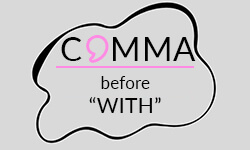
Placing commas is one of the most common struggles for students, which frequently results in conveying the wrong ideas in academic writing. Becoming familiar with the specific rules for commas is crucial to preventing such mistakes and bringing across the correct meaning. The following article deals with using a comma before “with” in particular, aiming to provide an extensive guide for you to make your academic work more understandable and clear.
When to place a comma before “with”
A comma is often used before “with” when it functions as a parenthetical or interrupting element in a sentence. In terms of this, a comma is placed before “with” when it introduces a non-restrictive or non-essential phrase or clause that is independent of the main clause. Additionally, “with” is preceded by a comma to emphasize contrasting compounds. For clarity, a comma is also set before “with” in lists or complex descriptions.
Comma
Parenthetical element
Non-restrictive clause
Contrasting components
Lists and series
Complex descriptions
No comma
Modifying phrase
Restrictive clause
Introducing direct objects
Continuous actions
Subject performing multiple actions
The comma rules may have exceptions for long and complex sentences. Additionally, certain rules may change according to the style guide being used. Essentially, it is imperative to ensure good readability and clarity in a sentence to determine whether to include a comma or not.
Comma before “with”
When “with” serves as a parenthetical or interrupting element in a sentence, a comma should be placed before “with.” This rule is also valid when “with” introduces non-restrictive and independent clauses and the sentence entails contrasting components, lists, or complex descriptions.
Parenthetical element
Commas are frequently used to separate words like “with” that are employed as brackets or interrupting elements in sentences.
Non-restrictive clause
A non-restrictive clause, also known as a non-defining or non-essential clause, provides additional information about a subject that isn’t essential to the basic meaning of the sentence. If you remove a non-restrictive clause, the core meaning of the sentence remains intact. Non-restrictive clauses are typically set off by commas, brackets, or dashes.
Contrasting components
A comma is placed before “with,” when it indicates and emphasizes a contrast between two ideas.
Lists and series
When a sentence contains a series of listed items and the last item is introduced with “with,” it is preceded by a comma for clarity.
Complex descriptions
When a sentence contains a complex description, e.g., if an element of a compound modifier describes a noun, it is advised to place a comma before “with.”
No comma before “with”
Avoid placing a comma before “with” if it introduces a modifying phrase, a restrictive clause, a direct object, continuous actions, or a subject that is connected to several actions.
Modifying phrase
If the word “with” initiates a single modifying phrase, e.g., the phrase modifies the subject, you typically do not place a comma.
Restrictive clause
Omit the comma before “with” when it integrates a clause essential to the meaning of the whole sentence.
Introducing direct objects
When a direct object following the verb is implied by “with,” the comma is usually skipped.
Continuous actions
When an action that is ongoing or continuous is linked to “with,” it is not preceded by a comma.
Subject performing multiple actions
When two or more actions are carried out by one subject and the last action is introduced by “with,” the comma is skipped.
Test yourself!
Practice sheet
Test your understanding of using commas before “with” by correctly placing them in 10 sentences. Check your answers in the second tab.
- The woman with the purple hair is my aunt.
- I prefer my coffee with oat milk and vanilla flavour.
- They finished the project with only minutes to spare.
- My friend with the new bike won the race.
- She’s traveling to Paris with hopes of seeing the Eiffel Tower.
- The girl with a loud voice always stands out in the choir.
- He ordered a pizza with mushrooms, olives, and peppers with garlic bread.
- It started hailing with no warning at all.
- He left the party early with his sister in tow.
- The bakery with the blue awning is the best in town.
- The woman with the purple hair is my aunt. (No comma, restrictive clause)
- I prefer my coffee with oat milk and vanilla flavour. (No comma, direct object)
- They finished the project with only minutes to spare. (No comma, continuous action)
- My friend with the new bike won the race. (No comma, restrictive clause)
- She’s traveling to Paris, with hopes of seeing the Eiffel Tower. (Comma, contrasting components)
- The girl with a loud voice always stands out in the choir. (No comma, restrictive clause)
- He ordered a pizza with mushrooms, olives, and peppers, with garlic bread. (Comma, list/series)
- It started hailing, with no warning at all. (Comma, contrasting components)
- He left the party early, with his sister in tow. (Comma, non-restrictive clause)
- The bakery with the blue awning is the best in town. (No comma, restrictive clause)
- ✓ 3D live preview of your individual configuration
- ✓ Free express delivery for every single purchase
- ✓ Top-notch bindings with customised embossing

FAQs
No, you should not always use a comma before “with.” It is mostly used when it implies a non-restrictive clause or parenthetical element.
There is a range of rules regarding the use of a comma before “with.” A comma is typically placed before “with,” when it introduces a parenthetical element, non-essential clause, contrasting components, list and series, or complex descriptions.
You generally do not use a comma before “with,” when it introduces a modifying phrase, restrictive clause, direct objects, continuous actions, and several actions linked to the same subject.
While it’s not conventional to use a comma before “with” in restrictive clauses, some writers might use it for emphasis or clarity, especially when the sentence structure or pacing benefits from a pause or to avoid ambiguity.
